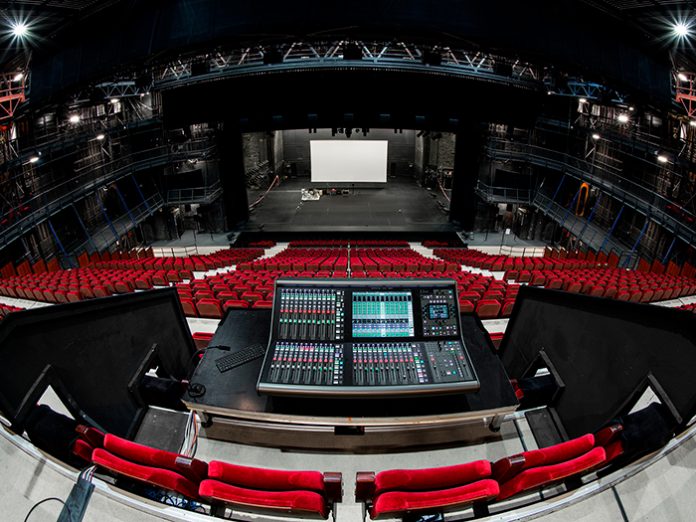French speaker manufacturer Amadeus, has announced the install of a ‘3D Sound’ system within Paris’ Chaillot National Theatre. Along with Solid State Logic (SSL), Lab.gruppen and Sonic Emotion, the four companies joined forces to design a one-of-a-kind electro-acoustic sound reinforcement system for the theatre, which is one of the most historical and prestigious in France. Amadeus has become one of the premiere manufacturers of high-end sound reinforcement systems for live and installed sound throughout Europe and Asia, while also designing and installing studio monitors. The Chaillot National Theatre’s new 3D sound system has already been used in the production of original contemporary dance productions featuring choreographers, dancers and actors including, Olivia Ruiz, Jean-Claude Gallotta, Carolyn Carlson, Aesoon Ahn, Antony Hamilton, José Montalvo, Thomas Lebrun, and Rocio Molina.
As the sound reinforcement system used in the Jean Vilar hall (1270 seats) was due to be replaced, Amadeus imagined a solution that would go beyond the limits of traditional technologies such as stereo, 5.1 multichannel format, or any conventional speaker system. The implemented solution uses the Wave Field Synthesis (WFS) technology. Like visual holograms, this ‘holophonic’ process captures or creates a sound stage by preserving spatial information: the distance and direction of the sound sources used.
“This technique allows to replicate the sound field’s physical properties. Wherever they are in the theatre, the listener keeps a coherent perception of the sources’ localisation,” explains Marc Piera, Chaillot National Theatre’s Sound Department Manager.
“I personally consider that the systems using a single-dimension speaker network, like line arrays, are inept for sound reinforcement in most theatre buildings,” adds Piera. “These systems were primarily designed for open field concerts, where the audience area is very wide and very deep, and most of the time, on a flat or lightly sloped ground. They create a uniform sound pressure field, but most often they degrade the sound image for most of the audience. The Jean Vilas hall’s intrinsic technical, acoustical, physical and mechanical properties led us to prefer an original sound reinforcement system, based on a ‘holophonic’ concept. Listening conditions are thus identical for all spectators, wherever they are in the hall.”
The Jean Vilar hall’s bleachers are segmented in four sub-spaces, each of different dimensions, seat numbers and slopes. The bleacher’s curvature is almost exponential, with 16°-, 23°-, 25°- and 35°-slopes. The control room sits 12 meters above the ground. The spectator area has a surface of 1122 sq. m (33m-deep, 34m-width).
Piera continues, “A traditional line source system, with constant or variable curvature, placed in a classical configuration, would inevitably have affected the sources’ localization, according to Haas’ effect. In the 1940s, this German scientist established that a source’s localization is given by the direction of the first sound reaching the ear (direct sound). If the difference between the spectator’s position, the primary source and the secondary source grows, the this effect becomes stronger.”
Chaillot National Theater Technical Manager, Denis Desanglois, says “The Chaillot National Theater is one of the five national French theatres. For a long time, it was an iconic ‘theatre for the people’ symbol, linked with famous names like Jean Vilar then Antoine Vitez. This place offers a large stage for dancers, with a viewing angle and a visibility on a par with their vitality. Our continuing mission is to develop and to support creation and diffusion of the works, and to foster their encounter with the widest audience possible.”
“We intended to replace our sound reinforcement system, which had not been completely satisfying until now,” explains Desanglois. “We wished to abandon the stereophonic paradigm, the line array-type. So we implemented a WFS-based system prototype and asked the companies we were working with for their feedback. Some technicians were totally initially disoriented, but eventually everyone was happy, technicians and artists alike. The sensations of listening are completely different, wherever you are in the hall, you experience the same sound, that’s pretty amazing.”
“We even integrated a 24-speaker ramp in the front end of the stage, to avoid the usual ‘sound hole’ first row of seats!” Desanglois concludes.
Based on Huygens’ Principle (1678), the idea of Wave Field Synthesis (WFS) was developed in the Netherlands in the 1980s by the Delft University of Technology. WFS concept makes it possible to synthesize “sound holograms” by simulating acoustic waves produced by virtual sound sources. To do this, the system uses a large number of loudspeakers, regularly spaced and used conjointly. They are each controlled with a delay and a gain to form a wave that emanates from the desired location of the virtual source. This process is repeated for each sound source in the sound scene. The major benefit of the WFS technique is to create a coherent sound field in an extensive area, therefore preserving the fidelity of the spatial image – the position of the sources – even for listeners located at the periphery of the zone or for listeners moving within the zone.
Michel Deluc, Amadeus’ R&D Manager, continues, “Edgard Varèse, one of the twentieth century’s pioneering composers in terms of sound spatialisation, said a century ago: ‘tomorrow’s music will be spatial’. At Amadeus, we have believed in this statement since the Company’s beginnings, in 1992. We worked with the Institut de Recherche et Coordination Acoustique/Musique (IRCAM), to develop the multichannel sound spatialisation equipment used in their Espace de Projection (ESPRO). This led us to develop the install’s 339 custom-made loudspeakers. Transposing this technology for the Chaillot National Theatre, thus allowing large audiences to experience it, is a thrilling and edifying challenge”.





